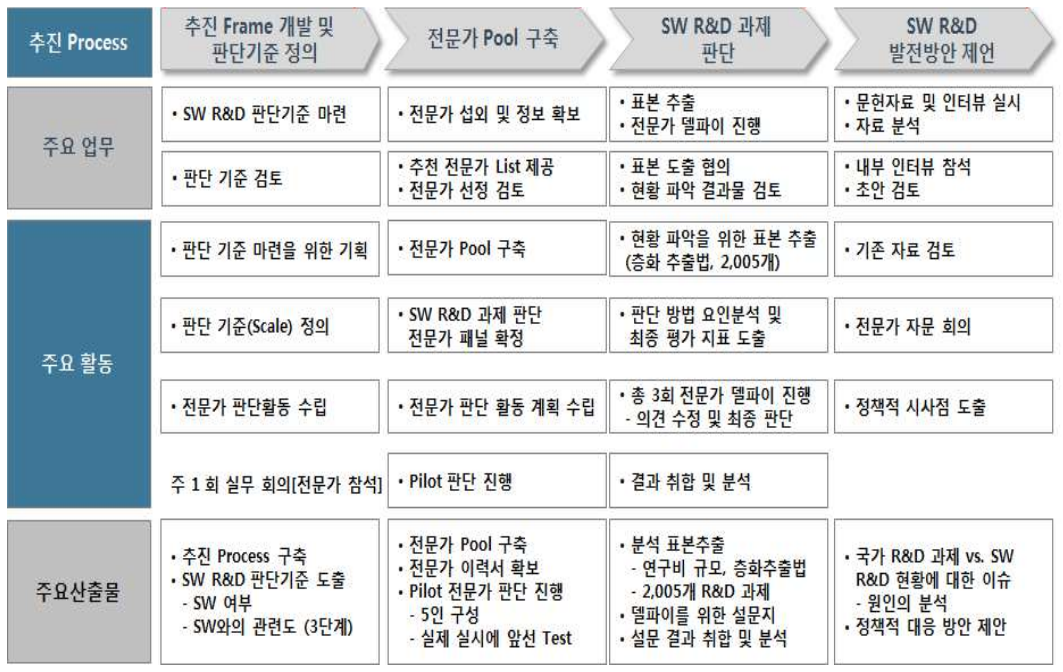
| 구분 | 주요 방법 |
|---|---|
| 분석 데이터 확보 | NTIS(국가과학기술지식정보서비스) DB의 2016년 국가연구개발사업의 과제 정보 및 성과 데이터 활용 |
| 연구방법론 선정 | 국가연구개발과제의 키워드 분석을 통한 정량적 분석 방법 검토 |
| 연구 방법론(델파이 기법) 선정 | |
| SW 융합 R&D 판단기준 마련 | SW 및 SW 융합 R&D의 정의 |
| 판단 척도(Scale) 및 합의 기준 정의 | |
| SW 융합 R&D 현황 파악 | 전문가 Pool 확보 및 운영 |
| 표본 도출 | |
| SW R&D 관련 전문가 델파이 조사 | |
| 델파이 결과 취합 및 분석 | |
| SW 융합 R&D 발전 방안 모색 | SW 융합 R&D 발전 방안 도출 |
| 전문가 자문회의를 통한 검증 수행 |
| Scale | Description |
|---|---|
| High | • 연구개발 활동의 대부분이 SW를 연구개발하는 과제 (80% 이상 ~ 100%) • EX. 새로운 Word Processor 개발, 스마트폰App(예: T Map) 개발, 새로운 알고리즘,Program Source 등 |
| Med High | • 많은 부분이 SW를 연구개발하는 활동이며, 이와 함께 부분적으로 비SW의 개선·개발을 추진 (60% 이상 ~ 80% 미만) • EX 1. SW의 전반적인 개선과 부분적 비SW 기능 추가 혹은 대체 • EX 2. 기존 내비게이션 시스템에 신규 기능(예 : AR/VR)을 주도적으로 추가 개발하고, 일부 출력용 HW 모듈을 함께 개발 |
| Medium | • SW와 비SW를 동시에 연구개발을 추진 (40% 이상 ~ 60% 미만) • EX. 기존내비게이션을 3D화하기 위한 관련 HW와 SW를 동시에 개발 |
| Med Low | • 부분적으로 SW를 연구개발하며, 대부분 새로운 비SW 연구개발을 추진 (20% 이상 ~ 40% 미만) • EX 1. 새로운 HW 개발에 따른 부분적 SW 수정 혹은 개발 • EX 2. 새로운 고속 처리 내비게이션 HW를 개발하고, 기존 내비게이션 SW를 일부 수정하여 포팅 |
| Low | • 기존 SW를 단순 활용하고, 대부분 새로운 비SW의 연구개발을 추진 (0% 이상 ~ 20% 미만) • EX 1. 안드로이드OS 포팅, SI (요구사항에 의한 단순 코딩 또는 활용) 등 • Ex 2. 새로운 고성능 내비게이션 디바이스를 개발하고, 기존 내비게이션 SW를 단순히 포팅하는 과제 |
| 구분 | 추출 표본 | 합의 Scale | SW R&D 합계(비중**) | ||||
|---|---|---|---|---|---|---|---|
| High | Med High | Medium | Med Low | ||||
| 과제 수 | (개) | 2,005 | 65 | 87 | 77 | 90 | 319 |
| (비중) | 20.4% | 27.3% | 24.1% | 28.2% | 15.9% | ||
| 정부 출연금 | 금액 | 589,425 | 22,409 | 18,929 | 27,398 | 24,382 | 93,119 |
| (비중) | 24.1% | 20.3% | 29.4% | 26.2% | 15.8% | ||
| 총 연구비* | 금액 | 750,965 | 21,734 | 24,474 | 42,470 | 33,371 | 122,050 |
| (비중) | 17.8% | 20.1% | 34.8% | 27.3% | 16.3% | ||
| 강도 고려한 총 연구비 | 금액 | 750,965 | 18,158 | 16,576 | 20,776 | 9,594 | 65,104 |
| (비중) | 27.9% | 25.5% | 31.9% | 14.7% | 8.7% | ||
| Category | Extract sample | Agreement Scale | SW R&D Total(%**) | ||||
|---|---|---|---|---|---|---|---|
| High | Med High | Medium | Med Low | ||||
| Project | (count) | 2,005 | 65 | 87 | 77 | 90 | 319 |
| (percentage) | 20.4% | 27.3% | 24.1% | 28.2% | 15.9% | ||
| Government Funding | Funding | 589,425 | 22,409 | 18,929 | 27,398 | 24,382 | 93,119 |
| (%) | 24.1% | 20.3% | 29.4% | 26.2% | 15.8% | ||
| Total Funding* | Funding | 750,965 | 21,734 | 24,474 | 42,470 | 33,371 | 122,050 |
| (%) | 17.8% | 20.1% | 34.8% | 27.3% | 16.3% | ||
| Total Funding considering the strength | Funding | 750,965 | 18,158 | 16,576 | 20,776 | 9,594 | 65,104 |
| (%) | 27.9% | 25.5% | 31.9% | 14.7% | 8.7% | ||